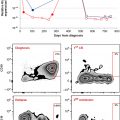Polycythemia Vera
1Peter MacCallum Cancer Center, Melbourne, VIC, Australia
2The University of Texas MD Anderson Cancer Center, Houston, TX, USA
1. Is it possible to have polycythemia vera (PV) without a JAK2 mutation?
In the era of widespread JAK2 mutation testing, it is easy to forget that many laboratories only routinely test for the JAK2V617F mutation in exon 14, which is present in approximately 95% of patients with true PV. A further approximately 4% will have mutations at various codons within exon 12 of the JAK2 gene, which can be tested for in some, but not all, academic centers and commercial labs. Rare mutations in other genes are described in patients with unexplained erythrocytosis, including mutations in LNK, and cooperating mutations or promoter hypomethylation in SOCS genes, TET2, or EZH2; testing for these mutations is not possible in everyday practice, and, therefore, it is possible to encounter a patient with true PV who is JAK2 mutation negative.
2. What is the optimal therapeutic hematocrit target in patients with PV?
There was considerable uncertainty about the importance of “strict” hematocrit control of 45% as claimed in earlier studies. In the European Collaboration of Low-Dose Aspirin in PV (ECLAP) study, a multinational prospective study of 1638 patients with PV, only 48% of patients were maintained at the recommended hematocrit target of <0.45, with the remainder maintained at 0.45–0.50 (39%) and >0.50 (13%). Interestingly, in the ECLAP study there was no relationship found between hematocrit level and risk of thrombosis, as had been previously reported, although it can be argued that the entire ECLAP cohort was undertreated as a whole, as reflected by the high event rate (3.2% major thrombosis per year). Analysis of the historic PVSG-01 study also failed to show a relationship between thrombosis and hematocrit, albeit at a liberal hematocrit target of 0.52. These older studies predated the modern practice of routine aspirin prescription and risk stratification by age and prior thrombosis; nevertheless, their results gave plenty of ammunition to proponents of liberal hematocrit targets.
Fortunately, the question of target hematocrit is now definitively answered with the recent publication of the CYTO-PV study. In this study, 365 patients with PV were randomized to hematocrit targets of <0.45 (low hematocrit) or 0.45–0.50 (high hematocrit). Notable differences between the CYTO-PV study and previous studies included the use of aspirin in all patients (unless contraindicated), and a recommendation for the use of hydroxyurea in high-risk patients (those age ≥65 years or with prior thrombosis). After a median follow-up of 31 months, major thrombosis or cardiovascular death occurred in 9.8% of the high-hematocrit group, compared with 2.7% of the low-hematocrit group (P = 0.007)—a remarkable difference, considering that the median hematocrit differed by only 0.03 between the two groups (0.44 vs. 0.47). The annual rate of major thrombosis or cardiovascular (CV) death in the high-hematocrit group (4.4% per year) was similar to that of the ECLAP study (3.2% per year), despite the routine prescription of aspirin and the use of hydroxyurea in high-risk patients in the CYTO-PV study. These observations confirm the critical importance of hematocrit control in PV, and highlight the ineffectiveness of aspirin and hydroxyurea in failing to overcome the adverse consequences of poor hematocrit control.
3. Should the hematocrit target differ between male and female patients with PV?
Traditionally, a target of 0.42 is often recommended for female patients. In the CYTO-PV patients, the therapeutic target was identical for male and female patients, and with the caveat of small numbers in subgroup analyses, the event rate in the high-hematocrit group was numerically higher in female (13%) than male (8%) patients. The CYTO-PV trial showed that reduction in hematocrit to physiological levels was important in preventing thrombosis, and if one extrapolates the physiological differences in hemoglobin in health to that in disease states, it would seem reasonable that the target for female patients should be lower than that of male patients. Although there is no prospective evidence at present to support this view, the judicious use of a lower hematocrit target (0.42) in female patients is unlikely to cause harm, and represents the authors’ personal practice.
4. Should extreme thrombocytosis in a patient with well-controlled hematocrit be an indication for cytoreductive therapy in PV?
There is a reasonable argument for the use of cytoreduction in extreme thrombocytosis (≥1500×109/L), due to the well-documented association between extreme thrombocytosis and bleeding risk from acquired von Willebrand factor deficiency. Unlike the situation with thrombosis risk, in which there are alternatives to cytoreduction (i.e., control of hematocrit and use of aspirin), the only therapeutic maneuver available to ameliorate the bleeding phenotype in extreme thrombocytosis is by cytoreduction; this practice is supported by expert opinions and consensus guidelines. The preferred choice of cytoreductive agent in this situation for younger patients would be interferon, while in older patients hydroxyurea is a standard of care.
5. Should leukocytosis with well-controlled hematocrit be an indication for cytoreductive therapy in PV?
The ECLAP study was able to provide insight into the association between white blood cell (WBC) count and thrombosis in PV. Two hundred and five thromboses occurred in 1638 patients followed for a mean of 2.7 years in the original ECLAP data set. Of these, 81 were first vascular events. Overall, the effect of leukocytosis was rather weak, being associated mainly with an increased risk of myocardial infarction when the WBC count exceeded 15×109/L. Aspirin is highly effective in the secondary prevention of recurrent vascular events in the general population, and data from ECLAP and studies of essential thrombocytosis suggest that aspirin use is associated with similar lowering of risk as a reduction in white cell count. In our view, these patients may well be equally served by aspirin therapy.
6. A patient develops a deep venous thrombosis (VTE) in the context of previously undiagnosed PV. What should be the duration of anticoagulation?







